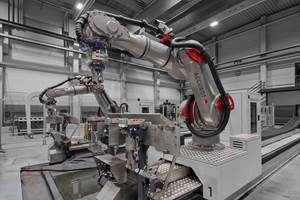CFM LEAP-1B engine begins flight test program
The engine features extensive use of carbon fiber and ceramic matrix composites.
CFM International (Melun, France) started the flight testing of the LEAP-1B engine on April 29 on a modified 747 flying test bed at GE Aviation Flight Test Operations in Victorville, CA.
The testing is the next milestone in a two-year program that will culminate in engine certification in 2016 and delivery of the first Boeing 737 MAX in 2017. The company says that the engine behaved well and completed multiple aeromechanical test points at various altitudes during the five-hour, 30-minute first flight.
"I continue to be really impressed with the LEAP family," said chief test pilot Steven Crane. "These engines are demonstrating a maturity that you don't always see in new products. I think our airline customers are going to be very pleased with this engine."
The LEAP-1B engine is the exclusive power plant for the Boeing 737 MAX family. The first engine began ground testing on June 13, 2014, three days ahead of the schedule set when the program was launched in 2011.
Over the next several weeks, the flight test program will encompass a comprehensive test schedule that will gauge engine operability, stall margin, performance, emissions and acoustics. It will also further validate the advanced technologies incorporated in the engine, including the woven carbon fiber composite fan, the Twin-Annular, Pre-Mixing Swirler (TAPS) combustor, ceramic matrix composite shrouds in the high-pressure turbine and titanium aluminide blades in the low-pressure turbine.
“With this major engine milestone and the test results to date we continue to be confident that the LEAP-1B-powered 737 MAX will provide our customers with the most fuel efficient, reliable and maintainable airplane in the single-aisle market,” said Keith Leverkuhn, vice president and general manager of the 737 MAX program for Boeing Commercial Airplanes. “The 737 MAX is on track to deliver 14% more fuel efficiency than today’s most efficient next-generation 737s and 20% more efficiency than the first next-generation 737s to enter service.”
There are currently a total of 26 LEAP engines (all three models) on test, with 10 additional engines in various stages of final assembly.
"The LEAP engine has been doing incredibly well throughout a very rigorous ground and flight test program," said Allen Paxson, CFM executive vice president. "All of these engines are heavily instrumented, many of them deliberately deteriorated, to calibrate performance and durability in the most extreme conditions. We have successfully completed several major certification tests, including icing, flocking bird ingestion, large-bird ingestion, and even a fan blade-out test. We have passed them all and the results are right in line with what we predicted and where we wanted this engine to be. We are on track to meet all of our commitments at entry into service."
This LEAP-1B engine is part of the most extensive ground and flight test certification program in CFM's history. The total program, which encompasses all three LEAP engine variants, includes 28 ground and CFM flight test engines, along with a total of 32 flight test engines for the aircraft manufacturers. Over a three-year span, these engines will accumulate approximately 40,000 engine cycles leading up to entry into service. By the time this engine enters service, CFM will have simulated more than 15 years of airline service with 60 different engine builds.
In 2011, Boeing selected the LEAP-1B as the sole power plant for its new 737 MAX, extending a more than 30-year relationship. CFM has been the only engine provider for the 737 aircraft family since the 737 Classic entered service in 1984.
Related Content
“Structured air” TPS safeguards composite structures
Powered by an 85% air/15% pure polyimide aerogel, Blueshift’s novel material system protects structures during transient thermal events from -200°C to beyond 2400°C for rockets, battery boxes and more.
Read MoreAutomated robotic NDT enhances capabilities for composites
Kineco Kaman Composites India uses a bespoke Fill Accubot ultrasonic testing system to boost inspection efficiency and productivity.
Read MoreIndustrializing additive manufacturing in the defense/aerospace sector
GA-ASI demonstrates a path forward for the use of additive technologies for composite tooling, flight-qualified parts.
Read MoreDevelopment of a composite liquid hydrogen tank for commercial aircraft
Netherlands consortium advances cryogenic composites testing, tank designs and manufacturing including AFP, hybrid winding, welding of tank components and integrated SHM and H2 sensors for demonstrators in 2025.
Read MoreRead Next
Scaling up, optimizing the flax fiber composite camper
Greenlander’s Sherpa RV cab, which is largely constructed from flax fiber/bio-epoxy sandwich panels, nears commercial production readiness and next-generation scale-up.
Read MoreUltrasonic welding for in-space manufacturing of CFRTP
Agile Ultrasonics and NASA trial robotic-compatible carbon fiber-reinforced thermoplastic ultrasonic welding technology for space structures.
Read MoreCutting 100 pounds, certification time for the X-59 nose cone
Swift Engineering used HyperX software to remove 100 pounds from 38-foot graphite/epoxy cored nose cone for X-59 supersonic aircraft.
Read More












